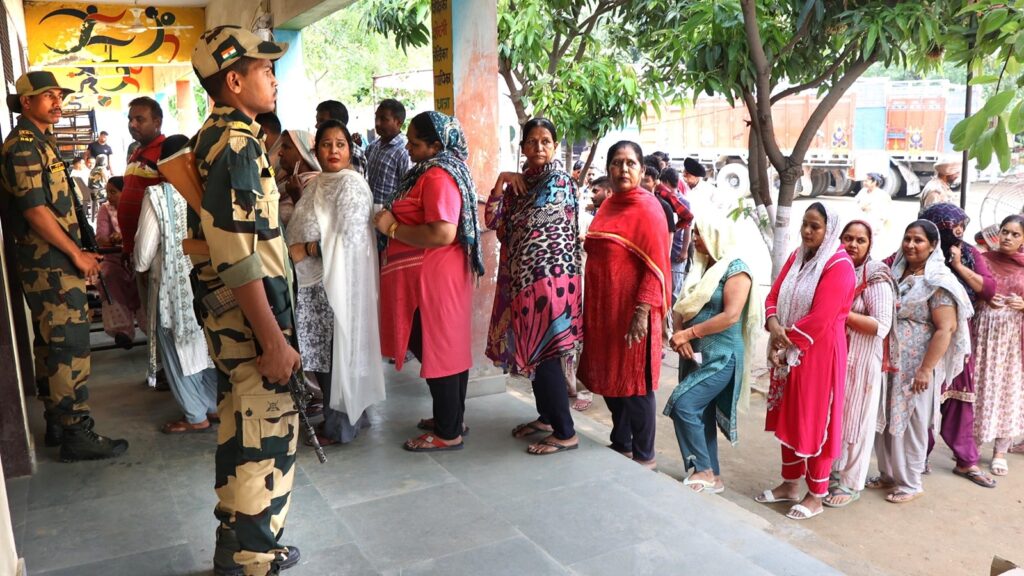From RJD leader Tejashwi Yadav promising one government job for every family to the Chief Minister Nitish Kumar-led NDA government’s Mukhyamantri Mahila Rozgar Yojana to grant 75 lakh women entrepreneurs Rs 10,000 each, youth and women remain the focus of Bihar elections.
But, as an analysis of past election manifestos shows, this is not new.
Women
Last month Prime Minister Narendra Modi and Nitish Kumar disbursed the first instalment under the Mukhyamantri Mahila Rojgar Yojana of Rs 10,000 each to 75 lakh “women entrepreneurs”, for a total outlay of Rs 7,500 crore. Under the scheme, the state government has promised to provide financial assistance of Rs 2 lakh each to women entrepreneurs after assessing their business initiatives.
In the last elections, in 2020, the JD(U) promised a similar scheme, of loans up to Rs 5 lakh with interest waivers for women-led enterprises. The BJP also promised a micro-financing push for women entrepreneurs through self-help groups.
The Nitish government has cultivated a women constituency with several women-centric welfare programmes since the beginning – from the Mukhyamantri Balika Cycle Yojana that gave high school girls bicycles to improve education access in 2006, to the JEEViKA programme to create self-help groups in 2007.
In 2018, the JD(U)-led government launched a financial assistance programme to provide Rs 25,000 each to girls who complete high school graduation. In 2020, the party manifesto further promised Rs 50,000 to unmarried women upon completing their graduate degrees.
The focus on women voters coincides with women turnout being consistently greater than men. In the 2020 Assembly elections, 60% of women electors voted compared to 54% of men. Out of Bihar’s 243 constituencies, women out-voted men in 167.
Moreover, survey data gathered by the Lokniti-CSDS after the 2020 elections found that 37.1% of respondents were aware of the schemes announced for them.
Youth
According to the Periodic Labour Force Survey (PLFS) published by the Ministry of Statistics and Programme Implementation, Bihar’s labour force participation rate (LFPR) among those aged 15 to 29 years stood at 34.6% (54.1% for men and 14.8% for women) in 2023-24. This is well below the India average of 46.5%, and only two states – Manipur and Mizoram – have lower LFPRs. Bihar’s overall LFPR was higher at 53.2% (75.8% for men and 30.5% for women), but even this was below the India average of 60.1% and above only two other states – Goa and Haryana – and the UTs of Puducherry and Lakshadweep.
However, Bihar’s unemployment rates of 9.9% for those aged 15 to 29 and 3% overall were marginally below the national averages at 10.2% and 3.2%, respectively.
According to Lokniti-CSDS’s post-poll survey data from 2020, 21% of voters cited unemployment, jobs, recruitment, and lack of industries as the major issues driving their voting decision.
Over the years, many schemes have been introduced with the aim of reducing unemployment in Bihar. More recently, just weeks before the Assembly polls were announced, the state government announced the grant of Rs 1,000 per month for two years to graduates and those who have completed Class 12 but remain unemployed. With an estimated 12 lakh youth to benefit from the scheme, the government is set to spend over Rs 2,800 crore over the next two years on this scheme.
In 2020, the Congress manifesto promised a monthly Rs 1,500 allowance to unemployed people, while the RJD said it would raise the number of workdays under the MNREGA from 100 to 200 days a year.
This time, Leader of the Opposition Tejashwi Yadav has promised that if the Mahagathbandhan came to power, it would ensure each family in the state has a government job. It’s a modification of the Opposition’s promise in 2020 to provide a job with minimum guaranteed wages to each family.
Education has also been a focus of parties’ promises. In 2015, months ahead of the Bihar polls, the Union government announced the establishment of an “AIIMS-like” institution for the state. But it was only September 2020, just before the state elections, that the Centre officially approved the project.
In 2015, just after the election result, when the JD(U)-RJD combine was briefly in power, the government announced five new medical colleges and one engineering, paramedical, and polytechnic college in every district. According to the National Medical Commission, by 2020, only the Jannayak Karpoori Thakur Medical College in Madhepura had been established.

